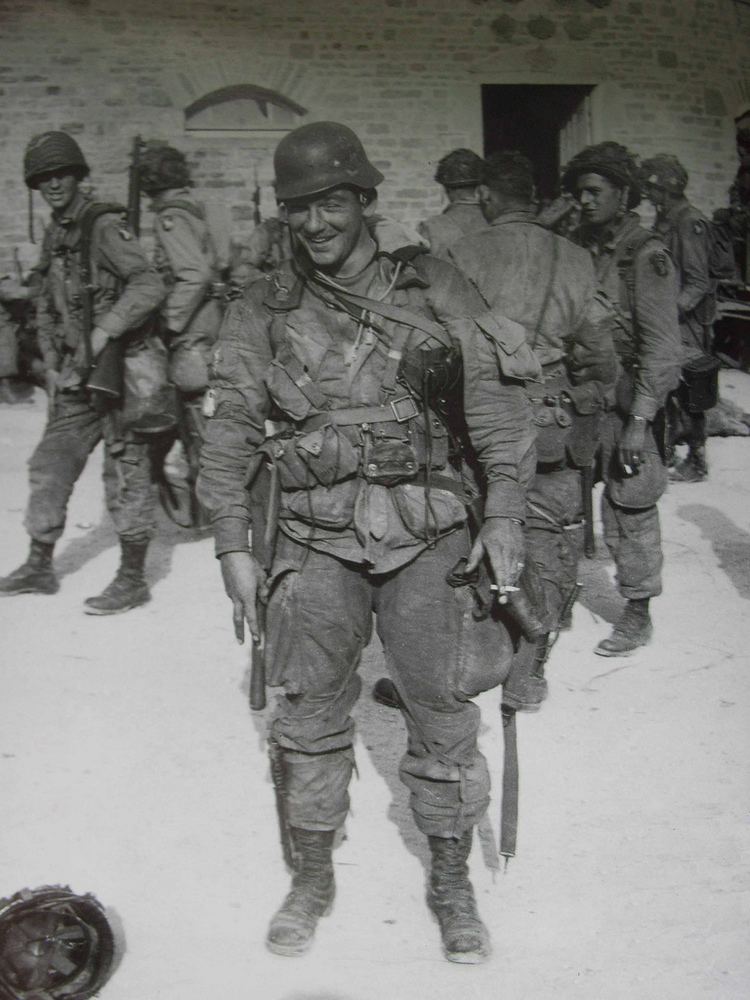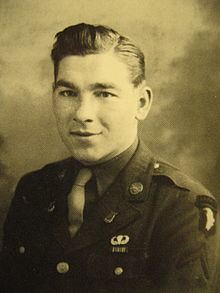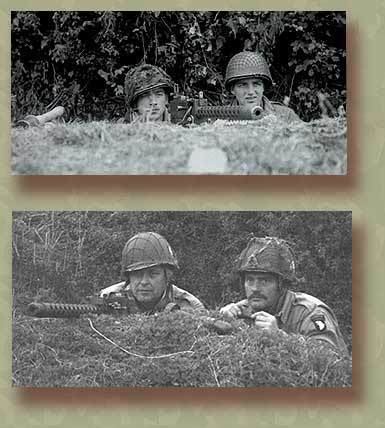Name Forrest Guth Rank Sergeant | Years of service 1942–1945 Allegiance United States | |
 | ||
Born February 6, 1921
Lehigh County, Pennsylvania ( 1921-02-06 ) Battles/wars World War II
Operation Neptune
Operation Market Garden
Battle of the Bulge Awards Purple Heart
Presidential Unit Citation 1 OLC
Good Conduct Medal
European-African-Middle Eastern Campaign Medal
World War II Victory Medal
Croix de guerre
French Liberation Medal
Combat Infantryman Badge
Parachutist Badge Died August 9, 2009, Hockessin, Delaware, United States Battles and wars Normandy landings, Operation Market Garden, Battle of the Bulge, World War II | ||
Nickname(s) "Goody", "Chow Hound" Service/branch United States Army | ||
Shifty powers forrest guth photo tribute
Sergeant Forrest L. Guth (6 February 1921 – 9 August 2009) was one of the 140 original members of the Easy Company, 2nd Battalion, 506th Parachute Infantry Regiment in the 101st Airborne Division, United States Army during the Second World War.
Contents
- Shifty powers forrest guth photo tribute
- Archive caporal forrest guth airborne en 2002 a bastogne
- Youth
- Paratrooper Training
- Military Service
- Later life
- Band of Brothers
- Forrest Guth in Museums
- References
Archive caporal forrest guth airborne en 2002 a bastogne
Youth

Forrest Guth (pronounced "Gooth") was born to John H. R. and Mayme L. Guth in the small district of Lehigh County, Pennsylvania. He is a direct descendant of the original German settlers who established themselves in the inland counties of eastern Pennsylvania in the 1700s. Forrest was brought up in Fogelsville, Pennsylvania, a suburb of Allentown, in Upper Macungie Township. Guth was fluent in the Pennsylvania Dutch dialect.

In 1941, Guth was working for Bethlehem Steel making armor plates for the Navy when the Japanese attack on Pearl Harbor occurred. At that time, working for the defense industry meant that he was advised not to join the army, as he was needed back at home producing steel plates. But Guth chose to enlist and volunteered for the paratroopers in 1942, becoming part of the original E Company, 506th Parachute Infantry Regiment.
Paratrooper Training

Guth went to Army Basic Combat Training at Camp Toccoa, Georgia where the Regiment's motto was born: "Currahee," named after the mountain where the regiment were forced to run the 6-mile round trip up and down daily. After parachute training at Fort Benning, Guth made his qualifying jumps and received his Jump Wings.
Easy Co. embarked on 5 September 1943, arriving at Liverpool, England. Guth was stationed in Aldbourne, Wiltshire. Training was carried out in preparation for the Invasion of France, and numerous full-equipment night-jumps were made. He and his unit were also involved in the pre-D-Day Exercise Tiger at Slapton Sands, Devon.
Military Service

Guth made his first combat jump into Normandy on 6 June 1944. He met, and joined with other unit members after landing in a meadow. The group found the remains of the crashed plane which contained Easy Company members. The group fought alongside a group of paratroopers from the 82nd Airborne division before joining their own unit to fight in Carentan.
On 17 September 1944, he jumped into the occupied Netherlands as part of Operation Market Garden. Guth was injured while landing because of a parachute malfunction and he was taken to an Army hospital in England. He rejoined Easy Company in Mourmelon, France, before the 101st Airborne Division were transported to Bastogne to fight in the Battle of the Bulge in December 1944.
In January 1945, Easy Company moved to Haguenau. Guth was selected for a patrol mission across the Moder River, led by Sergeant Ken Mercier because of his German speaking ability. In March 1945, whilst in Mourmelon, Guth won a thirty-day furlough to return to the States, and the war ended before Guth could rejoin his unit. Guth was discharged in mid-October 1945.
Guth was appreciated for his ability to keep all his weapons in prime condition, and his ability to repair and modify weapons. He became the armorer for his comrades. Guth even knew how to make an M-1 rifle fully automatic. Richard D. Winters got one of Guth's modified weapons, and took it with him when he set off for the Korean War.
Later life
Guth enrolled at Millersville State Teacher's College (now Millersville University) in Millersville, Pennsylvania. He then went to New York University to obtain his master's degree.
He became a teacher in Norfolk, Virginia, where he met his wife Harriet and they married in 1949. The couple moved to Delaware to work. He taught electronics at Brandywine High School and was the stage crew advisor. He continued to live there after their retirement. Guth died on 9 August 2009 in Hockessin, Delaware.
Band of Brothers
Although Guth was one of the original 140 Toccoa men of Easy Company, he was not included in the Band of Brothers TV miniseries, apart from briefly appearing as himself at the beginning of the eighth episode, The Patrol. His character was actually planned and his unique uniform, which had a lot of extra pockets, had been re-created. His role in the patrol as the interpreter in Haguenau was replaced by David Kenyon Webster in the episode of "The Last Patrol". In reality, Webster was not on that patrol, but was involved in the patrol assigned to cover the patrol from across the river with an M1919 Browning.
Forrest Guth in Museums
Original World War II uniforms and memorabilia of Forrest Guth are on display at these museums :
D-DAY PARATROOPERS HISTORICAL CENTER - Battle of NORMANDY - Saint-Côme-du-Mont, France
DECEMBER 44 MUSEUM - Battle of the BULGE - La Gleize, Belgium
